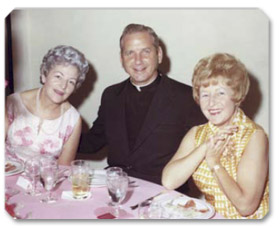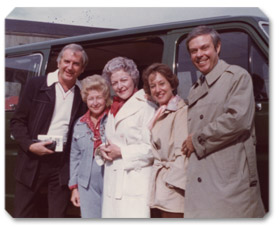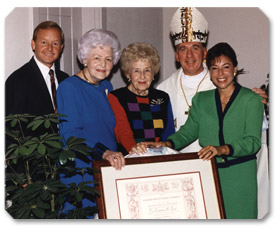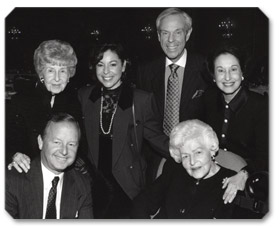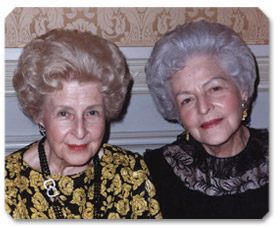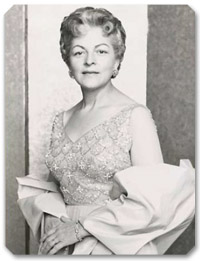|
CHAPTER FIVE Virginia devoted the last phase of her life almost entirely to sharing her wealth, time, and heartfelt empathy for those in need. In a career spanning nearly half a century, Virginia struck an admirable balance between a public life of philanthropic visibility and a private life of personal simplicity, and her use of her own wealth to raise the quality of life for countless others made her a tremendously powerful role model. She exemplified a woman of "unselfed" grace anchored in financial acuity, diplomatic tenacity, and independence of vision. Even in an era of self-determinant feminism, her life bore more weight in terms of what she chose to do for others than most. In the closing years of the twentieth century, as Virginia's physical health waned, women's authority in America had expanded to include nearly every aspect of public leadership. The Equal Rights Amendment had suffered defeat, gender discrimination and salary inequities still existed, and in the wake of a feminist backlash, some had even declared the movement dead. Still, college-aged Americans enrolled in women's studies courses, while ecofeminist and other grassroots organizations took on diverse forms and influences, proving feminism to be not only alive but adaptable and responsive to new issues and concerns of women. Virginia's work and her legacy were supported and upheld by this environment of increasing public feminist influence. Eventually, Virginia's self-imposed workload and the inevitable process of aging began to exact their tolls. In the early 1990s, she fell several times, accidents occasioned sometimes by her beloved cat, Gus. Meanwhile, degenerative neurological problems began to present themselves, and by 1995 her health had become so compromised that she chose to remain at home. Virginia had perfected a poised, public persona, but by 1995, when she was no longer able to maintain that persona, in accordance with her temperament she chose to recede from public view with dignity. She spent the last few years of her life attended by her longtime companion and devoted housekeeper, Helen Dusch, as well as a small cadre of dedicated nurses. As a solitary child in rural Idaho, Virginia's companions were composed mainly of animal friends. In her final years, confined to her home, Virginia's solitude once again included animal companions, but it was also blessed with family, relatives, and friends who daily expressed their love and appreciation of her kindness, generosity, and grace. Near the end, Virginia spoke daily, reverently, of her grandmother, Cora Higley, and of her first husband, Paul Galvin. She quoted Cora's gentle Christian Science tenets, blending them without conflict into her Catholic faith. Virginia had never been one to hold theological debates with herself or with others. Her spirituality was simple, practical, and inclusive, but her conversion to Catholicism in 1948 had influenced several of those closest to her to convert as well: her nephew Paul, her sister Carol, and friends Laura and Dayton Grafman. Both of Virginia's husbands were also practicing Catholics, as were many of her intimate friends, including, among others, Sister Ann Ida Gannon, Gladys Leach, Sister Mary Cyril Tirpak, the Hubatas, Father Michael Weishaar, and Father Frank Fernandez. Virginia had been a faithful daily Communicant, but in her final years, when she could no longer attend her favorite parishes, Bishop Thomas J. O'Brien came often to her home to celebrate Mass with her. Father Frank, too, a close friend and confidant, visited Virginia each Sunday to conduct Mass just for her. Many of those who remained close to Virginia in her final years came from the religious side of her life. Virginia did not press her spiritual beliefs on others. She did something far more challenging: she lived what she believed. Her life can be viewed as an ancient, archetypal tale-the hero's journey-a tale told worldwide in multiple guises, showing how to live beyond oneself, forging from flesh and temporality something enduring and fine. If the journey into selflessness were less arduous, Virginia's life might not present such an uncommon example. And certainly, self-reward could not have been Virginia's primary motive, nor her love of parties, or her enjoyment of social, charitable, and cultural events, though,despite innate shyness stemming in part from an isolated early childhood,Virginia did greatly enjoy these things. Instead, her primary motive can perhaps be attributed to a faith inspired initially by her grandmother's belief in Divine Truth and later by Paul, who kept a copy of the Beatitudes on his desk. Faith gave her the composure to bear the often taxing contradiction between isolation and celebrity. Virginia's spiritual convictions were the bedrock of strength she needed. She lived her faith the way she practiced her philanthropy, daily, enthusiastically, profoundly. After several years of increasing debilitation and declining health, Virginia Piper, a woman who had contributed millions of dollars to healthcare and medical research but who only reluctantly took medicine herself, died at the age of eighty-seven. In the early morning hours of June 14, 1999, at her home in Paradise Valley, Virginia G. Piper was, according to the tenets of her Catholic faith, "risen in Christ." Her last words were spoken to Carol, whose paintings Virginia had hung throughout her home. As Virginia's only sibling and closest confidante, Carol Critchfield had shared a unique place in the life of her older sister. As lifelong best friends, they called each other four and five times a day. So, as Virginia, days from death, lay on her bed in her home in Paradise Valley, her last words were addressed to Carol, the little sister she had fiercely protected and deeply cherished. "We have talked enough. That is all." History suggests that society manages to create its necessary leaders, but history also suggests there is often a vanguard of individuals who pave the way and forecast a new way of being in the world. Virginia G. Piper, through loss, opportunity, and upbringing, paved a path for both women and men to engage in more modern approaches to philanthropy. Virginia believed the best philanthropy was visionary, strategically integrated, and strengthened, if possible, multiple goals. Through her constant interest in children, education, arts and culture, healthcare and medical research, religion, and older adults, she wove an interconnected network of support that would provide the greatest social, educational, and cultural benefits. These benefits were not just intended for her lifetime but for all time. Virginia inspired (and still inspires through The Virginia G. Piper Charitable Trust) individuals and communities to give. Philanthropy, at its core, is love for humanity. Joyfully, Virginia embraced and encouraged others to embrace the personal and the communal affirmation of giving. Because Virginia lived her life so well, millions of Maricopa County citizens lead a better life. Virginia continues to inspire and aid us all. Future generations will be healthier, better educated, and live in a county that values arts and culture and believes in the spiritual and communal power of giving. |
|
| About the Author l Pipertrust.org | |








